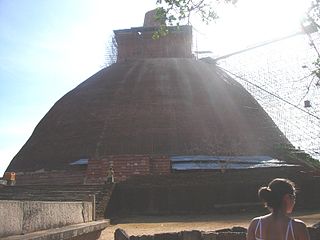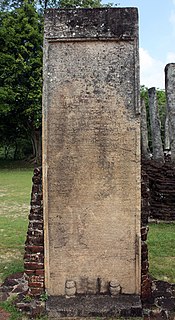
Queen Lilavati was the second woman in Sri Lankan history to rule as sovereign in her own right. Lilavati rose to prominence as the wife of Parakramabahu I, king of the Kingdom of Polonnaruwa. Being of royal descent herself, she then ruled as sole monarch on three different occasions in the near-anarchy following Parakramabahu's death, with the backing of various generals. The primary source for her life is the Culavamsa, specifically chapter LXXX.

Kalinga Magha also known as Magha the Tyrant and Kulankayan Cinkai Ariyan,. He is identified as the founder of the Jaffna kingdom and first king of the Aryacakravarti dynasty. According to the Segarāsasekara-Mālai belong the first Aryacakravarti king of Jaffna to Eastern Ganga dynasty of Kalinga, who were descendants of Western Gangas and Cholas. His family was connected to the rulers of Ramanathapuram in Tamil Nadu. Kalinga Magha’s relatives of Ramanathapuram administered the famous temple of Rameswaram. He usurped the throne from Parakrama Pandyan II of Polonnaruwa, in 1215. His reign saw the massive migration of Sinhalese to the south and west of Sri Lanka, and into the mountainous interior, in a bid to escape his power. Magha was the last ruler to have his seat in the traditional northern seat of native power on the island, known as Rajarata; so comprehensive was his destruction of Sinhalese power in the north that all of the successor kingdoms to Rajarata existed primarily in the south of the island.

Parākramabāhu I was king of the Kingdom of Polonnaruwa from 1153-86. During his reign from the capital city of Polonnaruwa, he unified the three lesser kingdoms of the island, becoming one of the last monarchs in Sri Lankan history to do so. He oversaw the expansion and beautification of his capital, constructed extensive irrigation systems, reorganized the country's army, reformed Buddhist practices, encouraged the arts and undertook military campaigns in South India and Burma. The adage "not even a little water that comes from the rain must flow into the ocean without being made useful to man" is one of his most famous utterances.
Kitti Sri Megha, also referred to as Kittisrimegha, was a medieval king of the principality of Dakkinadesa in Sri Lanka. The nephew of King Vijayabahu I, he attempted to seize the throne of Sri Lanka along with his two brothers in 1110 CE, but was defeated by Vickramabahu I. He then retreated to the south of the country, which he initially ruled with his younger brother Sri Vallabha. He later ascended to the throne of Dakkinadesa following the death of his older brother Manabharana.

Vijayabahu I was a medieval king of Sri Lanka. Born to a royal bloodline, he grew up at a time when, part of the country was occupied by invaders from the Chola Kingdom of Tamilakam. He assumed rulership of the Ruhuna principality in the southern parts of the country in 1055. Following a seventeen-year-long campaign, he successfully drove the Chola out of the island in 1070, reuniting the country for the first time in over a century. During his reign, he re-established Buddhism in Sri Lanka and repaired much of the damage caused to infrastructure during the wars. He offers Thihoshin Pagoda(Lord of Sri Lanka Buddha image) to Burma king Alaungsithu and it is now still in Pakokku.
Vijayabahu II (1186–1187) was king of the Kingdom of Polonnaruwa, in what is now Sri Lanka. He was the nephew of his predecessor, Parakramabahu I.

The Kingdom of Dambadeniya was a medieval kingdom in what is present day Sri Lanka. The kingdom's rulers reigned from 1220–1345.

Nissanka Malla, also known as Kirti Nissanka and Kalinga Lokesvara was a king of Sri Lanka who ruled the country from 1187 to 1196. He is known for his architectural constructions such as the Nissanka Lata Mandapaya, Hatadage and Rankot Vihara, as well as for the refurbishment of old temples and irrigation tanks.

Rankoth Vehera is a stupa located in the ancient city of Polonnaruwa in Sri Lanka. The stupa was built by Nissanka Malla of Polonnaruwa, who ruled the country from 1187 to 1196. The Rankoth Vehera has been built according to the tradition of the stupas of the Anuradhapura Maha Viharaya and bears a close resemblance to Ruwanwelisaya. In fact, a stone inscription situated close to the stupa even identifies it by the name "Ruwanweli". However, it has later come to be known by the currently used name, Rankoth Vehera. In Sinhalese, ran means gold, kotha is the name given to the pinnacle of a stupa, and vehera means stupa or temple. Thus, the name Rankoth Vehera can be roughly translated to English as "Gold Pinnacled Stupa". Along with the Kiri Vehera, it is one of the most revered stupas in Polonnaruwa.
Parakrama Pandyan II, also Parakrama Pandya of Polonnaruwa and Parakrama Pandu was a Pandyan king who invaded the Kingdom of Polonnaruwa in the thirteenth century and ruled from 1212 to 1215 CE. His namesake royal Parakrama Pandyan I ruled in Madurai fifty years earlier and had sought help from his contemporary Parakramabahu I of Polonnaruwa when faced with a Pandyan civil war. Parakrama Pandyan II came to the throne deposing Lilavati - ruling monarch, consort and successor of Parakramabahu I - as king of Polonnaruwa. He ruled for three years until Polonnaruwa was invaded and he was taken captive by Kalinga Magha, who succeeded him.

Sahassa Malla was King of Polonnaruwa in the thirteenth century. He ruled the Kingdom of Polonnaruwa from 1200 to 1202. He succeeded Lilavati, who was removed from the throne by her co-ministers. He was deposed by General Ayasmantha and succeeded by Kalyanavati. He was the younger brother of Nissanka Malla.
Anikanga was King of Polonnaruwa in the thirteenth century, who ruled from 1209 to 1209. He succeeded his son Dharmasoka, who was installed as king of Polonnaruwa, and was succeeded by Queen Lilavati. He reigned for 17 days.
Dharmasoka was an infant King of Polonnaruwa in the thirteenth century, who ruled from 1208 to 1209. He was three months old and installed as king by General Ayasmantha succeeding Kalyanavati as king of Polonnaruwa and was succeeded by his father Anikanga.

Bhuvanaikabahu I was King of Dambadeniya in the 13th century, who ruled from 1271 to 1283. He succeeded his brother Vijayabahu IV as King of Dambadeniya and was succeeded an Interregnum of 19 years. His nephew Parakkamabahu III ruled from Polonnaruwa, and was not formally considered as a King of Dambadeniya.
Dappula II was King of Anuradhapura in the 9th century, whose reign lasted from 807 to 812. He succeeded his father Mahinda II as King of Anuradhapura and was succeeded by his son Mahinda III.

The Polonnaruwa period was a period in the history of Sri Lanka from 1017, after the Chola conquest of Anuradhapura and when the center of administration was moved to Polonnaruwa, to the end of the Kingdom of Polonnaruwa in 1232.

The Transitional period of Sri Lanka spans from the end of the Kingdom of Polonnaruwa, in 1236, to the start of the Crisis of the Sixteenth Century. The period is characterised by the succession of capitals that followed the fall of the Polonnaruwa Kingdom and the creation of the Jaffna kingdom.









